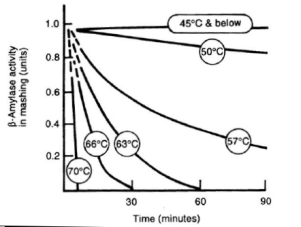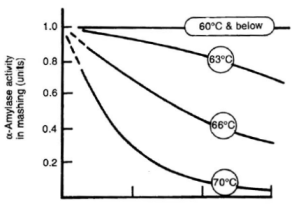A successful mash needs at least some period where both alpha and beta amylase are working co-operatively together, because alpha produces very few fermentable sugars and beta works much better when the alpha has broken down the starch a bit.
But there's a problem: alpha amylase doesn't work much below 63ºc, but by the time the mash reaches that temperature, quite a lot of the beta amylase has already been permanently damaged ('denatured').
Therefore it's very useful to understand how quickly the beta amylase is damaged at different temperatures and mash thicknesses.
Unfortunately while there are some figures bandied about on this, it's difficult to find really reliable data that is sourced to a scientific study.
Therefore I was really glad to find this paper from July 1990 by Robert Muller at the Brewing Research Foundation in Redhill, Surrey.
The whole paper is worth a read but Figure 1 below is particularly useful. It shows (on different scales) how quickly each type of amylase is destroyed at 65ºc (in a 2.5 litre/kg mash), which is a fairly common temperature chosen for a "balanced mix" of alpha versus beta activity.
The key observation is that the beta is destroyed much more quickly than the alpha, with the usable amount remaining halving every ten mins.
So after 30 mins about 83% of the beta amylase has been destroyed, and after 60 mins 92% of it is gone.
More than 50% of the alpha amylase is still going at this point, and will continue to increase the 'body' and perceived sweetness, but remember that the alpha produces very few fermentable sugars.
Muller's results are fairly consistent with work at the university of Vienna (quoted by Braukaiser) in figures 2 and 3, which shows how the rate of enzyme deactivation changes at different temperatures (spoiler: it drops off pretty fast).
Figure 1: Inactivation of enzymes at 65ºC (2.5:1 liquor to grist) [Muller 1990]

Figure 2: Qualitative BETA amylase inactivation at different temps [TU Vienna]

Figure 3: Qualitative ALPHA amylase inactivition at different temps [TU Vienna]

But there's a problem: alpha amylase doesn't work much below 63ºc, but by the time the mash reaches that temperature, quite a lot of the beta amylase has already been permanently damaged ('denatured').
Therefore it's very useful to understand how quickly the beta amylase is damaged at different temperatures and mash thicknesses.
Unfortunately while there are some figures bandied about on this, it's difficult to find really reliable data that is sourced to a scientific study.
Therefore I was really glad to find this paper from July 1990 by Robert Muller at the Brewing Research Foundation in Redhill, Surrey.
The whole paper is worth a read but Figure 1 below is particularly useful. It shows (on different scales) how quickly each type of amylase is destroyed at 65ºc (in a 2.5 litre/kg mash), which is a fairly common temperature chosen for a "balanced mix" of alpha versus beta activity.
The key observation is that the beta is destroyed much more quickly than the alpha, with the usable amount remaining halving every ten mins.
So after 30 mins about 83% of the beta amylase has been destroyed, and after 60 mins 92% of it is gone.
More than 50% of the alpha amylase is still going at this point, and will continue to increase the 'body' and perceived sweetness, but remember that the alpha produces very few fermentable sugars.
Muller's results are fairly consistent with work at the university of Vienna (quoted by Braukaiser) in figures 2 and 3, which shows how the rate of enzyme deactivation changes at different temperatures (spoiler: it drops off pretty fast).
Figure 1: Inactivation of enzymes at 65ºC (2.5:1 liquor to grist) [Muller 1990]

Figure 2: Qualitative BETA amylase inactivation at different temps [TU Vienna]

Figure 3: Qualitative ALPHA amylase inactivition at different temps [TU Vienna]





 . Hypothetically speaking (thinking) I wonder, for the “perfect beer”, what percentage of grain should be mashed at, say 63C to produce a very fermentable wort, and the remainder of the grain mashed at, say 69C to produce a less fermentable wort to provide the “body”. I’m thinking of 2 separate mashes done one after the other with fresh grain for each. I guess it would depend on the style but for a bitter, I wonder what the split would be?
. Hypothetically speaking (thinking) I wonder, for the “perfect beer”, what percentage of grain should be mashed at, say 63C to produce a very fermentable wort, and the remainder of the grain mashed at, say 69C to produce a less fermentable wort to provide the “body”. I’m thinking of 2 separate mashes done one after the other with fresh grain for each. I guess it would depend on the style but for a bitter, I wonder what the split would be? TETB
TETB
